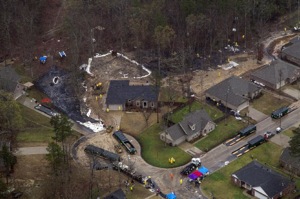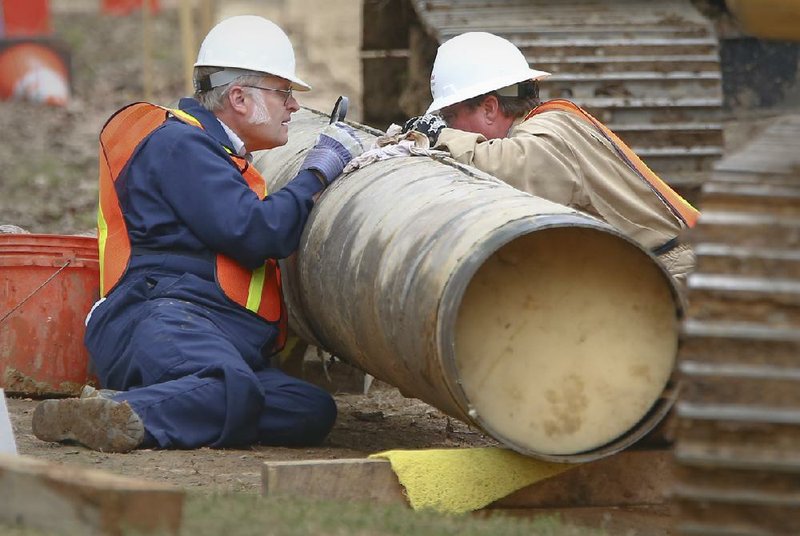Exxon Mobil will not restart its crude-oil pipeline that ruptured in a Mayflower subdivision March 29 and spilled tens of thousands of gallons of oil into the neighborhood before early next year at the soonest, a spokesman confirmed Tuesday.

The Arkansas Democrat-Gazette learned of the extensive shutdown after Exxon Mobil Corp. spokesman Aaron Stryk said a federal pipeline regulatory agency had granted the company a 90-day extension to file its work plan for the shuttered Pegasus pipeline, which runs from Illinois to the Texas Gulf Coast.
Stryk - asked if that delay meant the 850-mile-long pipeline could not conceivably resume operation before the 90 days have passed and likely thereafter - responded, “Correct.”
He said in an email that the subsidiary Exxon Mobil Pipeline Co. had “requested an extension of 90 days for submitting a Work Plan to verify the integrity of the line” to the federal Pipeline and Hazardous Materials Safety Administration, sometimes called PHMSA.
He would not comment on whether Exxon Mobil hopes eventually to restart the line rather than retire it - an option one executive at Exxon Mobil Pipeline Co. has previously said is “within the realm of possibilities.” Built in 1947-48, the Pegasus used a kind of pipe that is no longer being made and tends to fracture along the welded seams running the length of the pipeline.
The pipeline’s lengthy shutdown and the continued lack of details concerning the delay, meanwhile, led to caution from the Arkansas attorney general’s office and to strong criticism Tuesday from a pipeline-safety consultant with ties to the safety administration.
“We don’t believe the line should be restarted until we can be assured that Exxon has answered several key questions, including how they plan to safely operate this line across the Lake Maumelle watershed,” said Chief Deputy Attorney General Bradford Phelps.
Attorney General Dustin McDaniel, who was out of the country Tuesday, and U.S. Attorney Christopher Thyer have sued Exxon Mobil over the spill in U.S. District Court in Little Rock. That case is pending.
At Exxon Mobil, Stryk said the federal agency approved the extension for submitting the work plan on Oct. 8 “to allow for the completion of previously approved supplemental testing and analysis on the pipeline.”
“This additional testing will help us better understand all factors associated with the pipe failure and will assist in the development of a more effective Work Plan,” Stryk added.
In April, the regulatory agency ordered Exxon Mobil to submit the work plan within 90 days of the date the company submitted a laboratory’s report that examined the ruptured pipe’s metal. That report, turned in July 10, found manufacturing defects - cracking that it said likely occurred shortly after the pipe was manufactured and that worsened over time.
In that order, the federal agency told Exxon Mobil that the work plan must include, among other things, “additional field testing, inspections, and evaluations to determine whether and to what extent the conditions associated with the Failure or any other integrity-threatening conditions are present elsewhere on the Affected Pipeline.” The results of those tests and evaluations also must be provided to the agency.
The pipeline has been shut down for almost seven months, since the day it ruptured on the afternoon of March 29 in Mayflower’s Northwoods subdivision - an unusually long time in comparison with the time similar pipelines have been closed, said safety consultant Richard Kuprewicz, who serves on a technical advisory committee to the federal regulatory agency. By comparison, Enbridge Inc. asked to reopen a pipeline about two weeks after it ruptured July 26, 2010, spilling more than 840,000 gallons of crude oil into a creek and the Kalamazoo River in Michigan.
“I don’t know what to make of” the long shutdown, he said, referring to the Pegasus pipeline. “It seems rather peculiar. … in the sense that it’s been over six months and everybody ought to have a pretty good idea why this pipe failed” by now. “You can only study it so long.”
And now, with an even longer shutdown, people are going to wonder what’s going on, said Kuprewicz, who has been advising Central Arkansas Water on issues surrounding the pipeline that runs through the Lake Maumelle watershed, the drinking-water source for more than 400,000 central Arkansans.
“This whole secrecy thing is just getting in the way and is raising people’s suspicions,” he said. “The secrecy appears to be driven by Exxon Mobil.”
Kuprewicz said secrecy by Exxon Mobil and the federal government in this pipeline accident has been far worse than in most such accidents, even the much-larger Enbridge one.
He said he understands that the federal agency is bound by “some legal ramifications.”
But he added, “It’s not doing PHMSA any good to be sucked into this. By now they should be telling people why they need … additional analysis. It’s extremely unusual for this thing to go on as far as it’s gone and meanwhile information isn’t coming out. It’s unusual to have this line down as long as it’s been down.”
Stryk said he had no comment on Kuprewicz’s comments regarding secrecy.
In a September letter sent to some elected leaders and to Central Arkansas Water, however, Exxon Mobil’s Jeanne Mitchell, senior director of federal relations, said the company had been “providing unprecedented access to information to regulators, public officials, and CAW” since the Mayflower spill.
“While our investigation is not as expedient as some would like it to be, we will not rush our comprehensive review and analysis,” she wrote.
Exxon Mobil has estimated that the pipeline spilled 210,000 gallons of heavy crude oil into the Northwoods subdivision, drainage ditches and a cove of Lake Conway. Many of the residents of the 22 homes evacuated immediately after the rupture have not moved back. Two houses that Exxon Mobil bought from the owners were demolished recently because oil was beneath their foundations.
Front Section, Pages 1 on 10/23/2013

